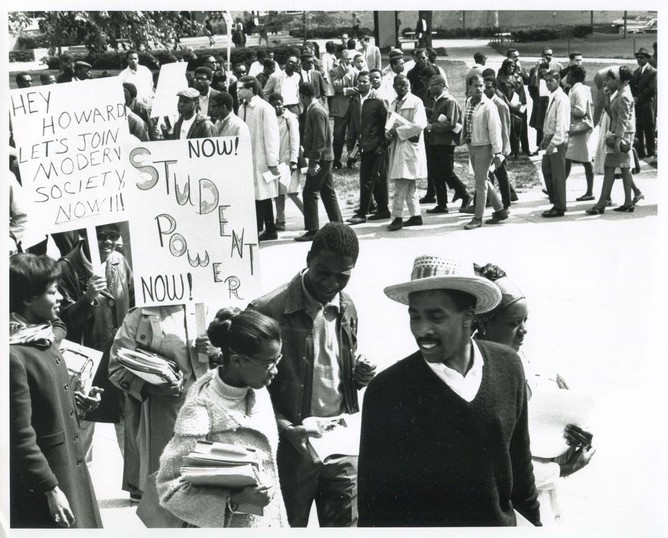The photograph Student Power evokes a sense of collective identity that is not only a representation of the people participating but also of the collective experience of student activism during the Civil Rights Movement. This photo shows a student group protesting outside of the administration building at Howard University. Located in Washington, DC. Howard University was one of the first large academic institutions to have student demonstrations in support of the Civil Rights Movement. Students at Howard University, through their active NAACP chapter, were engaging in direct action as early as the 1940s, making it one of the first institutions to house this kind of activism. Yet, the early student demonstrations were not without resistance. In 1944, Howard University’s president put an end to a scheduled fall semester demonstration, and “even threatened to suspend the NAACP and the students if the activities did not cease” (Bynum 40). In order to be part of the NAACP, participating students had to sign nonviolent consent forms so that volunteers were both risking the chance of expulsion and putting their lives in danger so as to openly protest segregation (Bynum 39). In so doing, these students “set a precedent for much of the large-scale student activity waged two decades later” (Bynum 40).
The signs the students are holding are calls to action. The front sign reads, “Now! Student Power Now!” The assertion, “Student Power” represents the voices of a generation that refuses to live without racial equality. The sign in the back reads, “Hey Howard Let’s Join Modern Society Now!!” specifically calling the Howard University community to action. Unlike the first sign, this one includes detailed context clues that allude to the time and location of the photo. Both signs use ‘now’ in order to stress the immediate need for change and support. Organizations used strong one-word statements like, “now” in calls to action to recruit more volunteers, raise awareness, and emphatically promote new integration ideals. Andreana Clay describes the experience of 1960 Civil Rights Movement groups in, The Hip-Hop Generation Fights Back: Youth, Activism, and Post-Civil Rights Politics, explaining that the student groups organized around a shared experience of the denial of civil rights so that “[u]ltimately, this organization drew upon and reflected a collective identity” (Clay 15).
